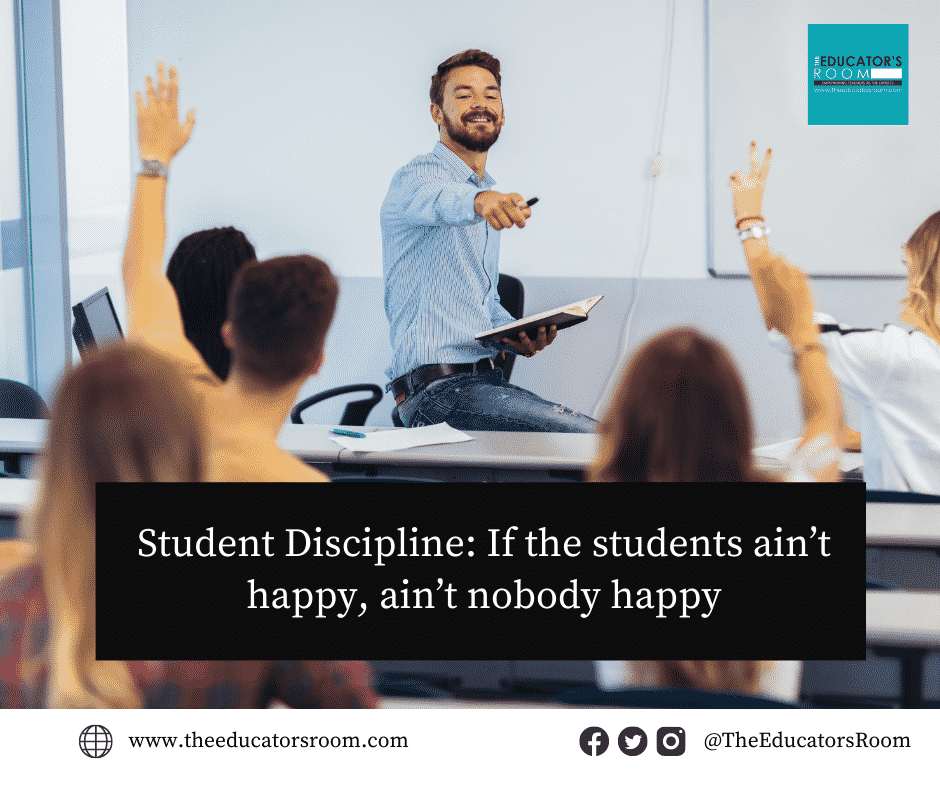
Cassidy Swinney is a high school teacher in Tupelo, Mississippi.
I remember my first classroom. It was bursting at the seams with posters, fairy lights, rugs, artwork, and anything that I could squeeze onto the walls in hopes of inspiring students to want to learn. My sweet Guinea pig students were not only dealing with me trying to find my feet as an educator, but they also had to battle the distractions they were fighting in trying to pay attention to me amongst the collage of my excitement suffocating them; on all sides!
I had great intentions, but we learned that intention does not equal success as we grow as educators.
One of my first assignments as a classroom teacher was to develop classroom rules. My first thought to myself was, “How can I control these kids so that I can create a productive learning environment?”
I began to brainstorm things like:
- No phones.
- No food or drink.
- No speaking without raising your hand.
- Stay in your seat.
When my students walked in and saw these brightly colored, well-intentioned rules, all they could see was, “NO, NO, NO, STAY!” I remember being a teenager. I didn’t even want to get my belly button pierced at 16 until my father told me that I was never allowed to. All of a sudden, all I could dream of was a sparkly navel. Much to my teenage dismay, my father stayed firm on his “No,” and my navel remained plain. Sure, I obeyed, but our relationship was rocky for a while, and if there had been 25 of me, his life would have been quite difficult.
- So the question then becomes, do we say yes?
- Do we unleash sparkly navels upon the world?
- Do we establish a zoo in room 24 and favor student happiness over control?
- Are rules for the birds?
Absolutely not.
While I will never claim to have all of the answers to any predicament, I have found a beautiful balance that works for me, and I’d like to share it.
The balance is this: if the students ain’t happy, ain’t nobody happy, but we have to remember that happiness is relative. Teenage happiness may appear in the form of wanting complete freedom. In reality, happiness for this child is a constructive environment with padded walls- walls that are prepared to receive pushback and give comfort.
Teenagers don’t stay teenagers forever, and take it from Romeo and Juliet: sometimes it is hard for teenagers to see past the moment in front of them. 15-year-old John wants to skip turning in his project because he hates writing essays, but 30-year-old John will appreciate that I called his mother 14 times and made him stay after school to finish.
15-year-old Sally wants to nap during my lecture, but 30-year-old Sally will be grateful that I woke her up 64 times during the 9th grade because she passed my course and can now go on to graduate. These 15 year-olds were grumpy, but the 30 year-olds were happy because of the loving restrictions placed around them.
Finding the balance between freedom and construction is difficult. We tell new teachers, “Don’t smile until October” or “They won’t work for you if they don’t like you,” and while these snippets offer great advice for specific situations, on their own, they will not yield happy students.
So, here are my current classroom rules:
1. Respect is mutual.
I have a huge sign on my wall that states, “Respect is expected from YOU and ME.” They will not all respect me because I am older. They will not listen to me just because I went to college. If they do not feel like I respect them, why would they listen to a word that I say? This is my number one classroom rule because it gives me power like no other. I pride myself on respecting students. I do not say “Shut-up,” and they are not allowed to say it either. I do not yell at them, and they are not allowed to yell at me. I do not extend deadlines for assignments (without special circumstances), and I do not take longer than specified to give back grades. During instruction, I am not on my phone, and they are not to be on theirs. I do not interrupt them, and they do not interrupt me (or one another). There is no double standard.
They respect me because I see them as people, not just as children.
2. Practice is practice, and practice is important.
Students are so much more than just students. They have jobs. They are siblings. They are athletes. They are struggling with anxiety and depression. They need to be treated as such. They need room to grow and to fall. When assigning work, especially in the day and age of the digital assignment dump (Canvas, Blackboard, Google Classroom), it is too easy to throw a bunch of assignments up and expect them to be turned in on Friday by midnight. Before the age of the digital dump, some assignments were group work. Some were teacher-led. Some were independent. That meant that not everything was for a grade, but it was still required because that was the expectation. Our expectations should not change just because we now have a more streamlined delivery of content.
What is the objective being assessed?
What happened to practice assignments?
In my room, we have three or four assignments posted each day, and the things that I am taking for a grade have asterisks by them (*). This lets my students know where their focus should lie.
In class, everything continues as normal. Because I am leading instruction and actively intervening during student-led work, we can practice without the pressure of everything being graded. My expectations of my students are that they will use the resources in front of them to the best of their ability. Many teachers say that if students know that something is not for a grade, they will not complete it. To some extent, sure. If you are not guiding them through practice, no, they will not do it. If my basketball coach sent out a text saying that I should run 3 miles and complete 100 free throws by myself before the game tomorrow, there is no way that I would practice because I knew he didn’t care to make sure that I did. If my coach is watching me and making sure that I am working- I am running and shooting. Students are the same way. They want to know that what they are doing matters. If you are preaching relevance and growth, practice becomes paramount. If they see that what they are learning is important through how you treat the material, they will care.
3. Consistency is everything. Decide what matters, and stick to it. Making nitpicky rules sets you up for failure. I did the whole “limited number of bathroom breaks” my first year teaching, and I swear that I spent more time tracking how many times my students went pee than I did grading (not really, but close). My students grab the pass, sign out, and go to the bathroom (one at a time) as long as a.) they are back in a reasonable amount of time and b.) they are not spotted being mischievous around campus.
Violations=permission needed.
My students are allowed to eat and drink as long as a.) they are clean and b.) on task. If A or B are violated, away goes the food. They can listen to music during independent work as long as a.) they keep one ear free for my interruptions and b.) assignments are turned in on time.
Violations=silence.
We read on yoga mats. We bring snacks whenever we are hungry. We listen to Jackson 5. We pee when we have to pee. My rules do not change because I am irritated or in a good mood. It is not hard for me to decide where to be firm or relaxed because everyone understands that the rules are the rules. We work hard, and everyone understands that as long as learning comes first, a school should be enjoyable. For the most part, these are my current classroom rules. These three rules create a place where everyone is relaxed, focused, and comfortable- including me! I can focus on content because of the culture within my room. I am ridiculously hard on my students, and for the most part, I love my job every day. It all comes back to something that my first principal would tell me: We work in customer service. Our entire job is to serve these kids. If they are not happy (in a 30-year-old way) with our service, we are not doing our jobs well.
**Disclaimer: Nothing works for everyone. Someone great once wrote, “but test everything, [and] Hold fast to what is good,” Spread your wings. Don’t be afraid to swap out a classic for a YA novel (scandalous). Don’t be afraid to create games to teach context clues. Don’t be afraid to make your classroom an enjoyable place to be.






